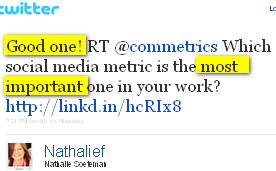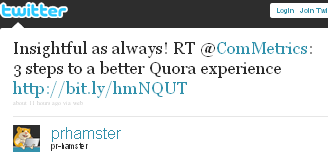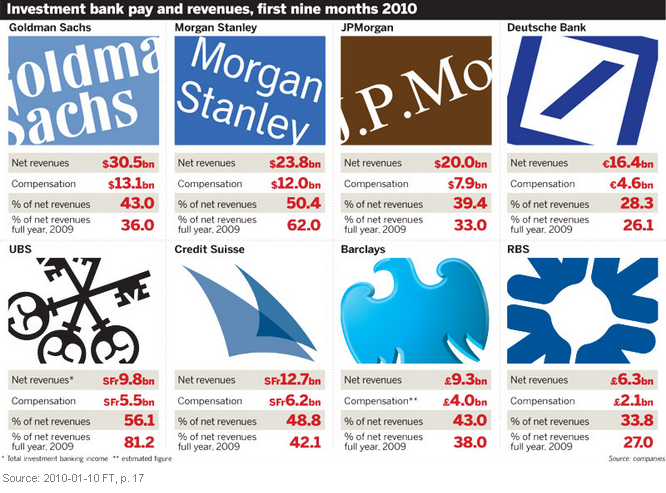Key performance indicators (KPIs) include actionable metrics that help you measure social media activities in ways that trigger actions. Those actions will hopefully help improve such operating metrics as customer complaints or returns.
This week I came across an interesting blog post by Devon Warwick that talked about using social media metrics when preparing your quarterly report for top management:
Learn more about how SMART metrics and KPIs can help you get your board to understand and support social media activities.
- Article source – ComMetrics weekly review: Your social media report to the bosses
- Rule 1: The usual fare will not do
 While I recommend that you grab low-hanging fruit like page views or unique visitors, these can be misleading.
While I recommend that you grab low-hanging fruit like page views or unique visitors, these can be misleading.
Tip 1: Provide the executive with a trend analysis, such as comparing the fourth quarter of 2010 with the same quarter from previous years. BUT, do not infer or deduce too much meaning from such numbers, since neither indicates more sales or fewer customer returns.
- Rule 2: Difficult metrics are not necessarily the right ones
A status update on search engine ranking for targeted keywords (e.g., what is used most often, etc.), a list of major sites/thought leaders that promoted your blog posts and so forth are more time-consuming to collect and measure than page views, but that does not always mean they are correspondingly useful.
Tip 2: Having a ‘major’ website or blog link to one of your posts or tweets is great. Nevertheless, this could simply be chance and hard to repeat, so keep your nose to the grindstone and frequently take many small steps to get you there faster. Waiting for the giant leap or link from BBC World that never materializes might not be a good strategy.
- Rule 3: Those feel-good metrics could lead you down a dangerous path
 Does having 60 percent of your employees blog have a more positive effect than 20 percent? And do lessons learned interest your management committee? Instead, it could be that getting their attention is much easier when discussing the last PR crisis and how you managed it.
Does having 60 percent of your employees blog have a more positive effect than 20 percent? And do lessons learned interest your management committee? Instead, it could be that getting their attention is much easier when discussing the last PR crisis and how you managed it.
If everybody tweets we might be proud of our staff. However, unless these tweets or blog posts are of real value to your target audience (i.e. current and potential customers crave your famous checklists), why should we care about this metric?
Tip 3: There is no perfect method for ranking social media except trial and error, along with a realization that perfection is impossible and good enough is all you can hope for in the real world.
- Bottom line and take-aways
No matter what metric you develop, unless there is a link between it and some key drivers/operating metrics such as calls to your client hotline, why should top management care?
Watching the trends is your best bet, but not necessarily by financial quarters, since comparing July, August and September 2010 to 2011 makes little sense in the northern hemisphere, where most people vacation during that time. Your traffic will drop, but since the trend is what matters, remember to look ahead as well.
Taking a page from the book of financial crises
Revenues are the most important drivers or operating metrics for financial institutions and other businesses. Of course, a critical actionable metric that helps explain why net revenues may be lower than expected – or understand the ‘why’ behind a result – is the amount of money paid out as compensation, usually in the form of bonuses.
By the way, I drafted and submitted a comment to Devon Warwick’s blog, but it failed to show up, so I sent an email. Unfortunately, I got no reply.
This experience reinforced what I already knew – in order to foster engagement, you must do two things:
- 1. Go the extra mile by checking your spam queue for false-positives.
2. Reply to all inquiries from your readers.
These actions will help further improve engagement metrics for any blog, not just Devon’s.
More resources:
If you like this post, please share it with your friends. How about asking them to comment after reading, I love to hear what people think!
Are you with me on these critical issues regarding actionable metrics and relating them to key drivers? Where do YOU see this going? Please leave a comment; the floor is yours!

Pingback: By @ShigoCreatives
Pingback: JobShoots
Pingback: Urs E. Gattiker
Pingback: MyComMetrics
Pingback: CyTRAP
Pingback: Urs E. Gattiker
Pingback: MyComMetrics
Pingback: Saurabh Uttam
Pingback: Devon Business Links
Pingback: Isabel Pina
Pingback: World Economic Forum
Pingback: Alex Hall
Pingback: pr-hamster
Pingback: Gary Wu
Pingback: Dan
Pingback: Dan